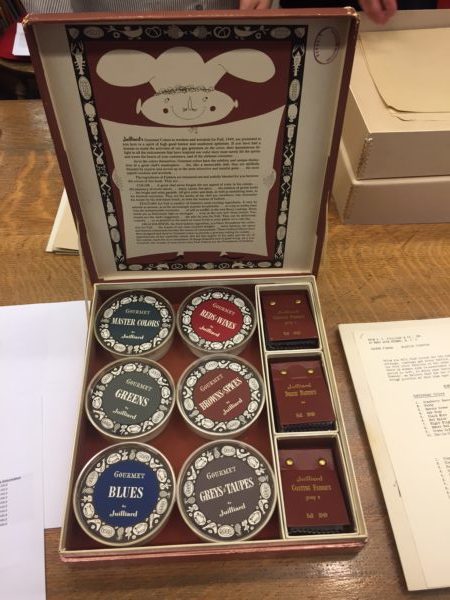While in New York our class was fortunate enough to visit the archive of the Brooklyn Museum. One of the pieces that we were shown was a whimsical little catalogue of dyed fabrics called Julliard’s Gourmet Colours from autumn 1949. In truth, the word ‘catalogue’ is loosely used to describe what was, in actuality, a treasure trove of beautiful fabric swatches, whacky illustrations and a plethora of food-related puns. These curious little boxes were local to New Jersey, only produced once or twice a year and were made for the benefit of clothing designers and manufacturers who may have been interested in using their fabrics.

The ways in which the accompanying booklets described the look and feel of their textiles was truly a work of poetry; the gastronomical metaphors perfectly embodying the potential haptic visuality of fabrics and clothing. The booklet states: “Gourmet colours have subtlety and unique distinction of a great chef’s masterpiece… for, like a memorable dish, they are skilfully blended by experts and served up in the most attractive and tasteful guise.” With dye names such as ‘cranberry sauce, ‘black mint’ and ‘hot spice’, it becomes easier to see how one might begin to view an outfit as a perfectly crafted meal with high quality ingredients.

They go on further to write that the texture of certain fabrics may be “smooth as a mousse… or crisp as melba toast, or soft as soufflé… or as deliciously light as meringue.” Here, language is used as a means to suggest that there is a desire to devour when looking at something we deem to be aesthetically pleasing. They also write: “these Julliard fabrics have been designed and dyed in Gourmet colours to provide a gracious setting for milady.” In this sense, an interesting comparison can be drawn between the way in which the fabrics are being described and the way in which the gaze operates within society. In describing fabrics using food-related terminology and comparing women’s fashion as a ‘gracious’ table setting, we can see how fashion might be used as a means to be devoured and ingested by the look of others. This quirky and unique fabric catalogue epitomises the tactile and digestive nature of looking in a manner that almost satirises and parodies the devouring potentiality of the gaze.
By Niall Billings


